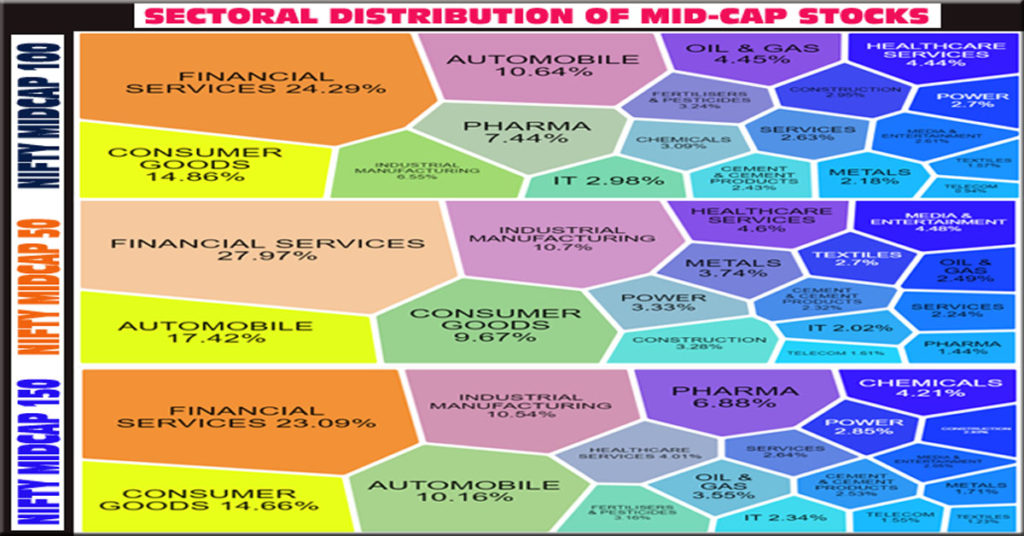What are Mid Cap Stocks?
The etymology of Mid Cap is derived from two words, Middle and capitalization(Mid Cap= Middle+Capitalisation). Companies with a market capitalization or market value between 5000 Cr. and 20000 Cr are termed as Midcap (mid-capitalization).
This indicates that the companies having such capitalization of 5000 Cr to 20000 Cr. And As the name implies such categorized (mid-cap company) stocks are placed in between Large-Cap and small-cap stocks.
A mid cap company falls within the middle between large-cap or big-cap and small-cap companies. Classifications, like large-cap, mid cap, and small-cap are approximations of a company’s current value; intrinsically, they’ll change over time.
However, The classification depends on the company’s rank within the benchmark indices like Sensex and Nifty. The businesses which are listed from 101st – 250th within the Nifty Index are generally considered mid cap companies. Nifty Midcap 50 is the benchmark mid cap index in India, which hosts the highest 50 most traded mid cap securities within the market.
Understanding Mid Cap Stocks
The company can raise capital when it’s needed. Two main ways are there- through debt or through equity.
- i) Through debt:
The debt must be paid back but can generally be borrowed and that must be at a lower rate than equity (due to tax advantages).
- ii) Through equity
Equity may cost more, but it doesn’t get to be paid back in times of crisis. As a result, companies can maintain a good balance between debt and equity. This balance is mentioned as a firm’s capital structure. Capital structure, especially equity capital structure, can tell investors tons about the expansion prospects for a corporation.
Why are the mid cap stocks attractive for investors?
A mid cap company could also be attractive for investors to invest in because, they’re expected to grow and increase in profits, market share, and productivity; they’re within the middle of their growth curve.
Since they’re still considered to be during a growth stage, they’re deemed to be less risky than small-caps, but riskier than large-caps. mainly due to an increase in their share prices, Successful mid cap companies run the risk of seeing their market capitalization rise, to the point where they fall out of the ‘mid cap’ category.
Advantages of Mid Caps
The key to minimizing the risk that most financial advisors suggest is a well-diversified portfolio; a mix of small-, mid and large-cap stocks should be selected to invest. However, some investors see mid cap stocks as how to diversify risk, as well.
Small-cap stocks offer the foremost growth potential, but that growth comes with the foremost risk. Large-cap stocks offer the foremost stability, but they provide lower growth prospects. Mid cap stocks represent a hybrid of the 2, providing a balance of growth and stability.
What are its Features?
Some of the crucial features of those stocks are discussed below –
- Diversity:
Mid cap shares vary in terms of returns and risks entailed though they lie on a broad spectrum bordering both small-cap and large-cap stocks. These.
Some mid cap companies could be nearing the developmental stage, and thus, might offer greater stability rather than returns; whereas some companies may need recently graduated from small-cap and thus allow greater returns compared to stability.
Chance of growth:
The chief characteristic of those stocks owned by mid cap companies in India is that they need a high potential to reinforce their productivity and profitability of market share.
During bullish market or market expansion, Investors can expect such companies to become an overnight success which can exponentially increase their returns.
Moderate risk:
Mid cap stocks respond with lower intensity to plug volatility in Comparing to small-cap stocks. However, they provide less stability during market contraction or bearish market compared to large-cap stocks.
Liquid:
Mid cap companies are well-known compared to small-cap stocks. These stocks are also relatively liquid and trustworthy to invest in for investors. Therefore, it becomes easier in mid cap shares to find buyers during a sale at a fair price.


